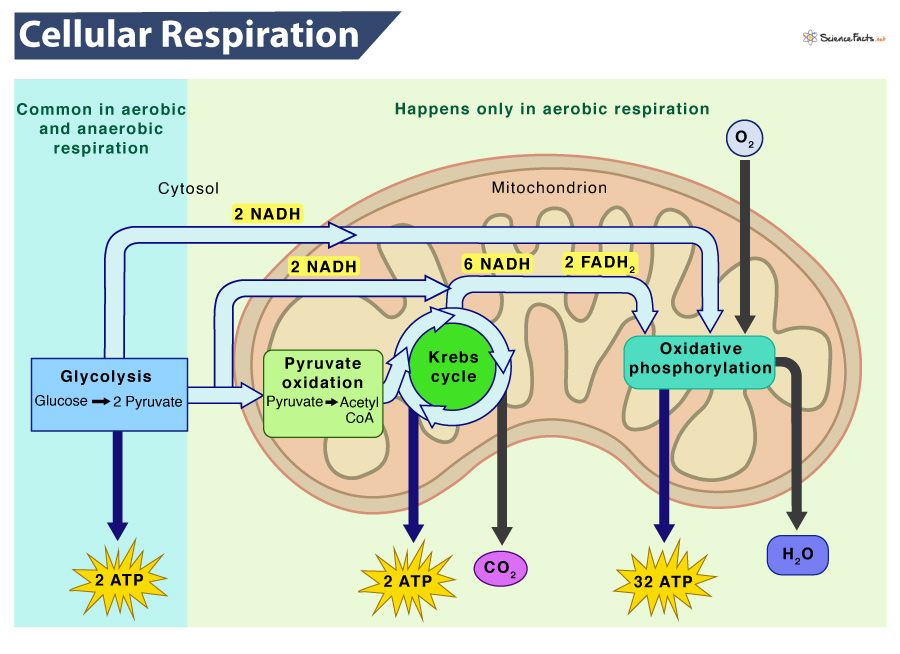Location: Where does it Take Place
Types with Equations
Process: What Happens during Cellular Respiration
Why is Cellular Respiration Important
Summary
1) Aerobic Respiration
It is so named, as here the glucose gets broken down in the presence of oxygen, producing ATP. Being autotrophs, plants produce their food by photosynthesis, whereas animals get their glucose by consuming food. The whole process initiates in the cell cytoplasm and is further carried out in the mitochondria. Here, water and carbon dioxide are also produced as end products along with energy. Besides ATP, other energy-rich molecules like nicotinamide adenine dinucleotide (NADH) and flavin adenine dinucleotide (FADH2) are also produced during the process, which releases ATP via the electron transport chain (ETC). Theoretically, 36 ATPs are formed at the end of aerobic respiration; however, some energy gets lost due to membrane leakage. The oxygen molecule in aerobic respiration acts as the final electron acceptor, resulting in the efficient production of ATP. Equation C6H12O6 (Glucose) + 6O2 (Oxygen) → 6CO2 (Carbon dioxide) + 6H2O (Water) + 36 ATP
2) Anaerobic Respiration
This type of cellular respiration occurs in the absence of free oxygen, producing acid or alcohol as the end product. Though it releases only 2 ATPs, it occurs more quickly than aerobic respiration. It is commonly found in prokaryotes residing in low-oxygen environments like deep-sea surfaces. Unlike aerobic respiration, here ions like sulfate or nitrate act as the final electron acceptor. The process occurs in the cell’s cytoplasm as the enzymes required for the process are present there. Equation C6H12O6 (Glucose) + Enzymes → 2C2H5OH (Ethanol) + 2CO2 (Carbon dioxide) + 2 ATP Fermentation is another anaerobic pathway for breaking down glucose. The two types of fermentation are discussed below: a) Lactic Acid Fermentation Lactic acid fermentation or lactate fermentation is an anaerobic process in which one glucose molecule splits into two lactic acid molecules. It occurs in the cytoplasm of the cells. Here, an NADH transfers its electrons directly to pyruvate, generating lactate as a byproduct. This type of fermentation commonly occurs in skeletal muscle when there is an insufficient oxygen supply to allow aerobic respiration to continue. Equation C6H12O6 (Glucose) + 2ADP + 2Pi (Inorganic phosphate) → 2C3H6O3 + 2ATP b) Alcoholic Fermentation Another type of fermentation, called alcoholic fermentation, produces alcohol called ethanol as a byproduct. It is also known as ethanol fermentation. Here, an NADH donates its electrons to a derivative of pyruvate, producing ethanol. Equation C6H12O6 (Glucose) + 2 ADP (depleted ATP) + 2 Pi (Inorganic phosphate) → 2 C2H5OH (ethyl alcohol) + 2 CO2 + 2 ATP
Steps of the Pathway: How it Works
Cellular respiration is a complex biochemical pathway that comprises four stages which are briefly discussed below:
1) Glycolysis
In the first step of cellular respiration, glycolysis, a glucose molecule undergoes a series of chemical transformations in the cytosol of all living cells. It is the only step that is shared by all types of respiration. As this step does not use oxygen, it is considered anaerobic. In the end, the glucose gets converted into two molecules of pyruvate, a three-carbon molecule. Along with pyruvate, the electron carrier NAD+ gets converted to 2NADH, and 2ATPs are made. Equation C6H12O6 + 2 NAD+ + 2 Pi + 2 ADP → 2 Pyruvate + 2 NADH + 2 ATP + 2 H2O + 2 H+
2) Pyruvate Oxidation
Next, each pyruvate from glycolysis enters the mitochondrial matrix. There it is oxidized to acetyl-CoA and CO2 by the pyruvate dehydrogenase complex (PDC). During this conversion, one molecule of NADH is generated. Equation Pyruvate + NAD+ + CoA → Acetyl-CoA + NADH + CO2 + H+
3) Citric acid Cycle (Krebs Cycle)
The citric acid cycle is also known as the Krebs cycle or the tricarboxylic acid cycle. In this step, the acetyl CoA produced in the previous step combines with a four-carbon molecule and undergoes a cycle of reactions, ultimately regenerating the starting four-carbon molecule. As one glucose molecule generates two acetyl-CoA, two cycles are required per glucose molecule. After completing the two cycles, the end products are 6 NADH, 2 FADH2, 4 CO2, and 2 ATP. Equation 2 Acetyl CoA + 6 NAD+ + 2 FAD + 2 ADP + 2 Pi + 2H2O → 4 CO2 + 6 NADH + 2 FADH2 + 2 ATP + 2 CoA
4) Oxidative Phosphorylation
The NADH and FADH2 made in other steps deposit their electrons in the electron transport chain (ETC), turning back into NAD+ and FAD. As electrons move down the chain, energy is released, and protons are pumped out of the matrix, forming a gradient. Protons again flow back into the matrix through an enzyme called ATP synthase, making ATP. At the end of the ETC, oxygen accepts electrons and takes up protons to form water. In eukaryotes, this process occurs in the mitochondrial cristae. Equation NADH + ½ O2 + H+ + ADP + Pi → NAD+ + ATP + H2O
